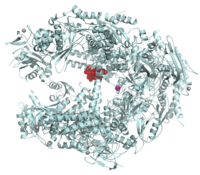
Photo from wikipedia
ABSTRACT Side chain-containing steroids are ubiquitous constituents of biological membranes that are persistent to biodegradation. Aerobic, steroid-degrading bacteria employ oxygenases for isoprenoid side chain and tetracyclic steran ring cleavage. In… Click to show full abstract
ABSTRACT Side chain-containing steroids are ubiquitous constituents of biological membranes that are persistent to biodegradation. Aerobic, steroid-degrading bacteria employ oxygenases for isoprenoid side chain and tetracyclic steran ring cleavage. In contrast, a Mo-containing steroid C-25 dehydrogenase (S25DH) of the dimethyl sulfoxide (DMSO) reductase family catalyzes the oxygen-independent hydroxylation of tertiary C-25 in the anaerobic, cholesterol-degrading bacterium Sterolibacterium denitrificans. Its genome contains eight paralogous genes encoding active site α-subunits of putative S25DH-like proteins. The difficult enrichment of labile, oxygen-sensitive S25DH from the wild-type bacteria and the inability of its active heterologous production have largely hampered the study of S25DH-like gene products. Here we established a heterologous expression platform for the three structural genes of S25DH subunits together with an essential chaperone in the denitrifying betaproteobacterium Thauera aromatica K172. Using this system, S25DH1 and three isoenzymes (S25DH2, S25DH3, and S25DH4) were overproduced in a soluble, active form allowing a straightforward purification of nontagged αβγ complexes. All S25DHs contained molybdenum, four [4Fe-4S] clusters, one [3Fe-4S] cluster, and heme B and catalyzed the specific, water-dependent C-25 hydroxylations of various 4-en-3-one forms of phytosterols and zoosterols. Crude extracts from T. aromatica expressing genes encoding S25DH1 catalyzed the hydroxylation of vitamin D3 (VD3) to the clinically relevant 25-OH-VD3 with >95% yield at a rate 6.5-fold higher than that of wild-type bacterial extracts; the specific activity of recombinant S25DH1 was twofold higher than that of wild-type enzyme. These results demonstrate the potential application of the established expression platform for 25-OH-VD3 synthesis and pave the way for the characterization of previously genetically inaccessible S25DH-like Mo enzymes of the DMSO reductase family. IMPORTANCE Steroids are ubiquitous bioactive compounds, some of which are considered an emerging class of micropollutants. Their degradation by microorganisms is the major process of steroid elimination from the environment. While oxygenase-dependent steroid degradation in aerobes has been studied for more than 40 years, initial insights into the anoxic steroid degradation have only recently been obtained. Molybdenum-dependent steroid C25 dehydrogenases (S25DHs) have been proposed to catalyze oxygen-independent side chain hydroxylations of globally abundant zoo-, phyto-, and mycosterols; however, so far, their lability has allowed only the initial characterization of a single S25DH. Here we report on a heterologous gene expression platform that allowed for easy isolation and characterization of four highly active S25DH isoenzymes. The results obtained demonstrate the key role of S25DHs during anoxic degradation of various steroids. Moreover, the platform is valuable for the efficient enzymatic hydroxylation of vitamin D3 to its clinically relevant C-25-OH form. IMPORTANCE Steroids are ubiquitous bioactive compounds, some of which are considered an emerging class of micropollutants. Their degradation by microorganisms is the major process of steroid elimination from the environment. While oxygenase-dependent steroid degradation in aerobes has been studied for more than 40 years, initial insights into the anoxic steroid degradation have only recently been obtained. Molybdenum-dependent steroid C-25 dehydrogenases (S25DHs) have been proposed to catalyze oxygen-independent side chain hydroxylations of globally abundant zoo-, phyto-, and mycosterols; however, so far, their lability has allowed only the initial characterization of a single S25DH. Here we report on a heterologous gene expression platform that allowed for easy isolation and characterization of four highly active S25DH isoenzymes. The results obtained demonstrate the key role of S25DHs during anoxic degradation of various steroids. Moreover, the platform is valuable for the efficient enzymatic hydroxylation of vitamin D3 to its clinically relevant C-25-OH form.
Journal Title: mBio
Year Published: 2018
Link to full text (if available)
Share on Social Media: Sign Up to like & get
recommendations!